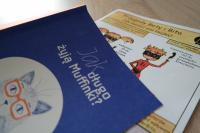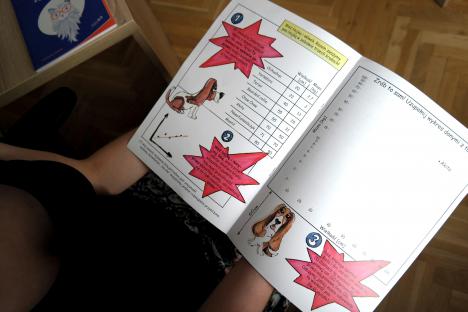How to Weigh a Dog with a Ruler – Mathematics for Everyone
Maths can be fun. You only need a bit of effort to convince elementary, middle and high school students. The Warsaw University of Technology professor Przemysław Biecek, DSc (Eng), from the Faculty of Mathematics and Information Science, has been introducing the “queen of sciences” to children for several years.
The idea is to prepare interesting teaching aids, both for pupils and their teachers, as well as for parents. “There are many riddles and games, but we were determined to create aids around identifiable characters”, said the scientist from the Warsaw University of Technology.
Thus, a boy and a girl became the protagonists – Beta and Byte [Bit]. “My day-to-day work involves statistics and data analysis, which combines mathematics and programming”, professor Biecek explains. “Therefore, Beta is passionate about mathematics, while Byte is a computer maniac, and together they complement each other.
A few projects were created so far around this idea.
Adventures of Beta and Byte
Among other things, a comic book with the adventures of Beta and Byte was published as a part of the eNgage competition for the popularization of science, organized by the Foundation for Polish Science. Its main topic is “How to Weigh a Dog with a Ruler?” The objective is for the children to determine the weight of a dog met in a park based on information about its size. Sizes and weights of different dog species are helpful in solving this problem. In this way, children learn to notice relationships between different data sets. And when they learn how to weigh dogs, the next task will be to weigh dinosaurs!
There are more stories about Beta and Byte. They are also the protagonists of the following short stories: “Pieczara Pietraszki” [Pietraszko’s Cavern] (co-written by professor Biecek and Magda Chudzian) and “Jak długo żyją Muffinki?” [How Long Do the Muffins Live?]. These stories introduce the world of mathematics to the youngest readers in an interesting, unique way.
The Children’s University is still supporting the development of the Beta and Byte project. This cooperation began in February 2016 with the organization of workshops for approx. 200 children divided into 12 groups. The courses took place during three subsequent Saturdays, and their main topic were, of course, the adventures of Beta and Byte. “Martyna Śpiewak, student of the Faculty of Mathematics and Information Science at the Warsaw University of Technology, and Agnieszka Tomczyk, student at the Łódź University of Technology helped with preparing and conducting the workshops”, said Przemysław Biecek. Similar workshops also took place in several schools in Łódź and Warsaw.
The comic book and short stories about Beta and Byte are available at www.BetaBit.wiki, where they can be legally downloaded for free, and used however you want.
The project website also contains games played in the R programming language. These are meant for older children, aware of the first steps of programming.
Foreign viewers will also take advantage of aids available at the website – most of them have English versions.
Stat Tube – an Idea for Interesting Lessons
Actions of the scientist from the Warsaw University of Technology do not end, however, with a website dedicated to Beta and Byte.
Until the end of July, funds are being raised for Stat Tubes on the 'PolakPotrafi' crowdfunding website (https://polakpotrafi.pl/projekt/jak-zwazyc-psa-linijka). Stat Tube is a collaboration project of Przemysław Biecek and Agnieszka Tomczyk. The Tube contains materials that may be used by a teacher or parent during lessons or additional courses. “Children will easily learn what estimation is”, said professor Biecek, “they will work in pairs. First, they will measure each other, and then they will place the results on the graph. They will look for relationships between the arm span and height. They will see how, if they have someone’s shoe, they can measure how tall its owner is.”
The Stat Tube contains measures, metrics, a sheet for drawing curves, caps for marking data and instruction on how to conduct lessons using these aids. “It is a lot of fun for the children, when there is someone other than their teacher showing them interesting things during a lesson”, said Przemysław Biecek. “If it’s a mother or father of one of the students – great. A parent that works, e.g. at a bank, can tell kids how they use statistics every day at work. The children see that it’s interesting, and maybe they will want to engage in such topics in the future. Not everyone is a mathematician, but it’s important not to discourage them early on.
As a part of the Stat Tube project, Przemysław Biecek and Agnieszka Tomczyk want to organize five away workshops, and to build at least 25 Stat Tubes filled with teaching aids to send to various schools. The total cost of this project is PLN 9.5 thousand.
Like a Family Movie
The scientist from the Warsaw University of Technology emphasizes that the more different approaches used to show mathematics, the better the chance to approach a wider group of children. “I was reading different books as a child, books with adventures and tasks”, he reminisces. “I particularly remember ‘Wakacje z gramolami’ [Holidays with Gramoles]”. These books really influenced my interests. Then, I wanted to get my children to be interested in my work. The finished stories about Beta and Byte are an attempt to introduce order to our conversations.
How does a scientist from the University of Technology find himself working with children? “The intensity of courses is very different”, he explains. “Children’s attention on a single topic is short-lived, you cannot lose this attention. You have to enkindle and maintain their interest. Children interpret words such as “optimization” differently from students of the University of Technology. They do not have a sophisticated mathematical apparatus. But if you avoid unnecessarily difficult words, it turns out that children are capable of understanding much more than you would expect. Children are curious about new experiences, they have a fantastic memory and absorb information like a sponge. Some intuitions related to statistics will remain in their memory.
There are plans for further aids, e.g. a comic book used to playfully estimate different sizes, as well as a comic book introducing programming using the R language to the reader based on data analysis of TV series. “It would be perfect to create aids that would resemble a family movie, i.e. a film where everyone can find something for themselves: younger and older children, parents, teachers”, said Przemysław Biecek. “It is easier to engage younger children in data analysis, if they see that it engages older children too”.
Agnieszka Kapela
Office for Promotion and Information









